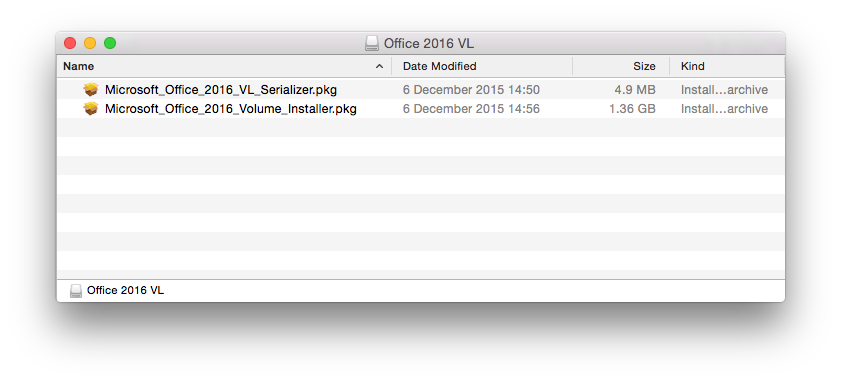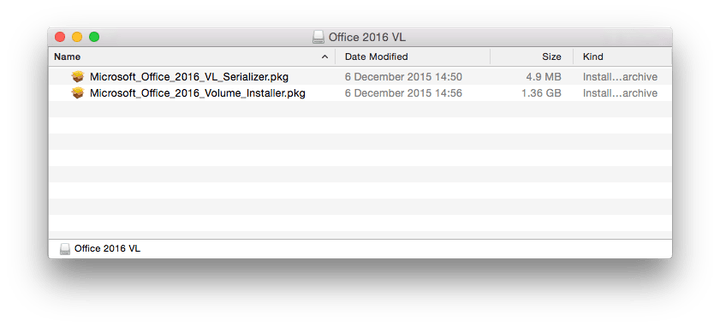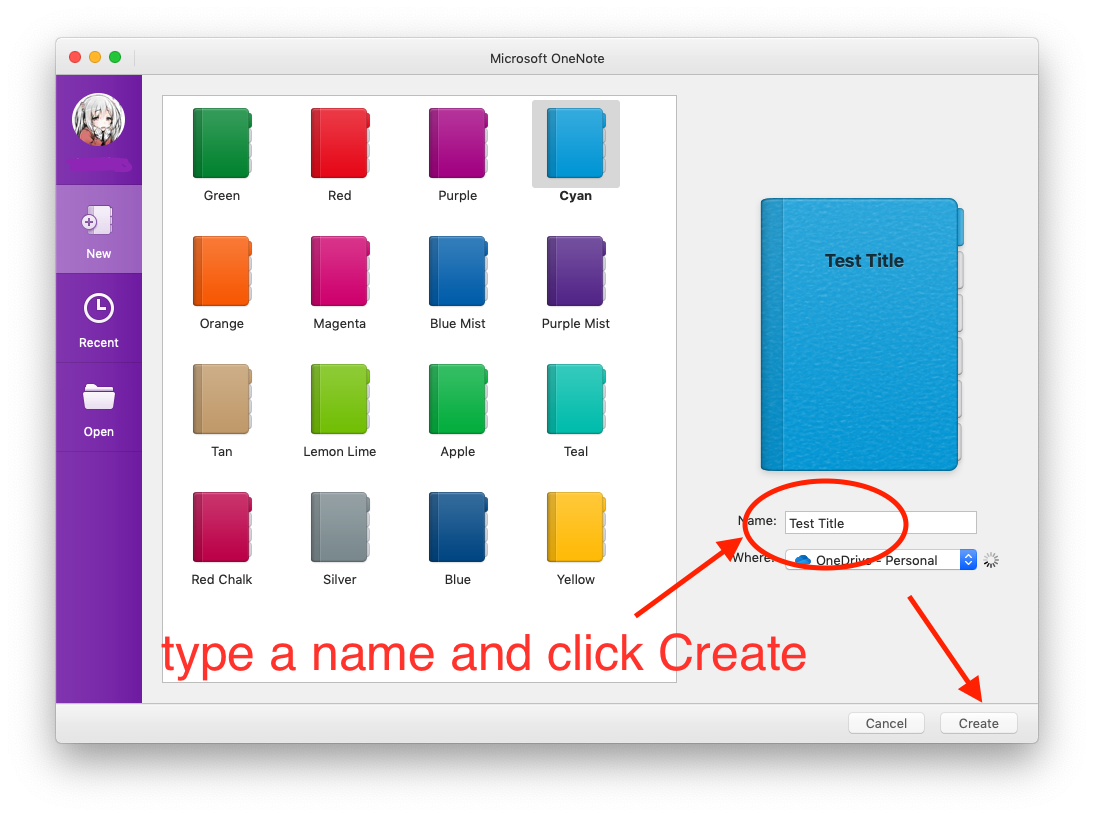The XML Serializer Generator creates an XML serialization assembly for types in a specified assembly. The serialization assembly improves the startup performance of a XmlSerializer when it serializes or deserializes objects of the specified types. Serialization is the process of converting an object into a stream of bytes to store the object or transmit it to memory, a database, or a file. Its main purpose is to save the state of an object in order to be able to recreate it when needed. The reverse process is called deserialization. Jan 09, 2020 Office 2019 VL Serializer problem on OSX Dear all, after a trial period with an installation of Office 365 I need to roll-back to the normal desktop installation with a VL license. Dec 16, 2020 System.Text.Json is the built-in JavaScript Object Notation (JSON) serialization library in.NET for converting from.NET object types to a JSON string, and vice versa, supporting UTF-8 text encoding. It was first added in.NET Core 3.0. A popular type in the library is JsonSerializer, which provides the highest level of functionality for.
-->Definition
Important
Some information relates to prerelease product that may be substantially modified before it’s released. Microsoft makes no warranties, express or implied, with respect to the information provided here.
Provides functionality to serialize objects or value types to JSON and to deserialize JSON into objects or value types.
Remarks
For more information, see How to serialize and deserialize JSON.
Methods
| Deserialize(ReadOnlySpan<Byte>, Type, JsonSerializerContext) | Parses the UTF-8 encoded text representing a single JSON value into a |
| Deserialize(ReadOnlySpan<Byte>, Type, JsonSerializerOptions) | Parses the UTF-8 encoded text representing a single JSON value into an instance of a specified type. |
| Deserialize(ReadOnlySpan<Char>, Type, JsonSerializerContext) | Parses the text representing a single JSON value into a |
| Deserialize(ReadOnlySpan<Char>, Type, JsonSerializerOptions) | Parses the text representing a single JSON value into an instance of a specified type. |
| Deserialize(String, Type, JsonSerializerContext) | Parses the text representing a single JSON value into a |
| Deserialize(String, Type, JsonSerializerOptions) | Parses the text representing a single JSON value into an instance of a specified type. |
| Deserialize(Utf8JsonReader, Type, JsonSerializerContext) | Reads one JSON value (including objects or arrays) from the provided reader into a |
| Deserialize(Utf8JsonReader, Type, JsonSerializerOptions) | Reads one JSON value (including objects or arrays) from the provided reader and converts it into an instance of a specified type. |
| Deserialize<TValue>(ReadOnlySpan<Byte>, JsonSerializerOptions) | Parses the UTF-8 encoded text representing a single JSON value into an instance of the type specified by a generic type parameter. |
| Deserialize<TValue>(ReadOnlySpan<Byte>, JsonTypeInfo<TValue>) | Parses the UTF-8 encoded text representing a single JSON value into a |
| Deserialize<TValue>(ReadOnlySpan<Char>, JsonSerializerOptions) | Parses the text representing a single JSON value into an instance of the type specified by a generic type parameter. |
| Deserialize<TValue>(ReadOnlySpan<Char>, JsonTypeInfo<TValue>) | Parses the text representing a single JSON value into a |
| Deserialize<TValue>(String, JsonSerializerOptions) | Parses the text representing a single JSON value into an instance of the type specified by a generic type parameter. |
| Deserialize<TValue>(String, JsonTypeInfo<TValue>) | Parses the text representing a single JSON value into a |
| Deserialize<TValue>(Utf8JsonReader, JsonSerializerOptions) | Reads one JSON value (including objects or arrays) from the provided reader into an instance of the type specified by a generic type parameter. |
| Deserialize<TValue>(Utf8JsonReader, JsonTypeInfo<TValue>) | Reads one JSON value (including objects or arrays) from the provided reader into a |
| DeserializeAsync(Stream, Type, JsonSerializerContext, CancellationToken) | Reads the UTF-8 encoded text representing a single JSON value into a |
| DeserializeAsync(Stream, Type, JsonSerializerOptions, CancellationToken) | Asynchronously reads the UTF-8 encoded text representing a single JSON value into an instance of a specified type. Xcom 2 viper mods. The stream will be read to completion. |
| DeserializeAsync<TValue>(Stream, JsonSerializerOptions, CancellationToken) | Asynchronously reads the UTF-8 encoded text representing a single JSON value into an instance of a type specified by a generic type parameter. The stream will be read to completion. |
| DeserializeAsync<TValue>(Stream, JsonTypeInfo<TValue>, CancellationToken) | Reads the UTF-8 encoded text representing a single JSON value into a |
| DeserializeAsyncEnumerable<TValue>(Stream, JsonSerializerOptions, CancellationToken) | Wraps the UTF-8 encoded text into an IAsyncEnumerable<T> that can be used to deserialize root-level JSON arrays in a streaming manner. |
| Serialize(Object, Type, JsonSerializerContext) | Converts the provided value into a String. |
| Serialize(Object, Type, JsonSerializerOptions) | Converts the value of a specified type into a JSON string. |
| Serialize(Utf8JsonWriter, Object, Type, JsonSerializerContext) | Writes one JSON value (including objects or arrays) to the provided writer. |
| Serialize(Utf8JsonWriter, Object, Type, JsonSerializerOptions) | Writes the JSON representation of the specified type to the provided writer. |
| Serialize<TValue>(TValue, JsonSerializerOptions) | Converts the value of a type specified by a generic type parameter into a JSON string. |
| Serialize<TValue>(TValue, JsonTypeInfo<TValue>) | Converts the provided value into a String. Adobe creative suite 7 for mac middle east version. |
| Serialize<TValue>(Utf8JsonWriter, TValue, JsonSerializerOptions) | Writes the JSON representation of a type specified by a generic type parameter to the provided writer. |
| Serialize<TValue>(Utf8JsonWriter, TValue, JsonTypeInfo<TValue>) | Writes one JSON value (including objects or arrays) to the provided writer. |
| SerializeAsync(Stream, Object, Type, JsonSerializerContext, CancellationToken) | Converts the provided value to UTF-8 encoded JSON text and write it to the Stream. |
| SerializeAsync(Stream, Object, Type, JsonSerializerOptions, CancellationToken) | Asynchronously converts the value of a specified type to UTF-8 encoded JSON text and writes it to the specified stream. |
| SerializeAsync<TValue>(Stream, TValue, JsonSerializerOptions, CancellationToken) | Asynchronously converts a value of a type specified by a generic type parameter to UTF-8 encoded JSON text and writes it to a stream. |
| SerializeAsync<TValue>(Stream, TValue, JsonTypeInfo<TValue>, CancellationToken) | Converts the provided value to UTF-8 encoded JSON text and write it to the Stream. |
| SerializeToUtf8Bytes(Object, Type, JsonSerializerContext) | Converts the provided value into a Byte array. |
| SerializeToUtf8Bytes(Object, Type, JsonSerializerOptions) | Converts a value of the specified type into a JSON string, encoded as UTF-8 bytes. |
| SerializeToUtf8Bytes<TValue>(TValue, JsonSerializerOptions) | Converts the value of a type specified by a generic type parameter into a JSON string, encoded as UTF-8 bytes. |
| SerializeToUtf8Bytes<TValue>(TValue, JsonTypeInfo<TValue>) | Converts the provided value into a Byte array. |
Applies to
 -->
-->Serialization is the process of converting an object into a stream of bytes to store the object or transmit it to memory, a database, or a file. Its main purpose is to save the state of an object in order to be able to recreate it when needed. The reverse process is called deserialization.
How serialization works
This illustration shows the overall process of serialization:
The object is serialized to a stream that carries the data. The stream may also have information about the object's type, such as its version, culture, and assembly name. From that stream, the object can be stored in a database, a file, or memory.
Tools
Uses for serialization
Serialization allows the developer to save the state of an object and re-create it as needed, providing storage of objects as well as data exchange. Through serialization, a developer can perform actions such as:
- Sending the object to a remote application by using a web service
- Passing an object from one domain to another
- Passing an object through a firewall as a JSON or XML string
- Maintaining security or user-specific information across applications
JSON serialization
The System.Text.Json namespace contains classes for JavaScript Object Notation (JSON) serialization and deserialization. JSON is an open standard that is commonly used for sharing data across the web.
JSON serialization serializes the public properties of an object into a string, byte array, or stream that conforms to the RFC 8259 JSON specification. To control the way JsonSerializer serializes or deserializes an instance of the class:
- Use a JsonSerializerOptions object
- Apply attributes from the System.Text.Json.Serialization namespace to classes or properties
Binary and XML serialization
The System.Runtime.Serialization namespace contains classes for binary and XML serialization and deserialization.
Binary serialization uses binary encoding to produce compact serialization for uses such as storage or socket-based network streams. In binary serialization, all members, even members that are read-only, are serialized, and performance is enhanced.

Warning
Binary serialization can be dangerous. For more information, see BinaryFormatter security guide.
XML serialization serializes the public fields and properties of an object, or the parameters and return values of methods, into an XML stream that conforms to a specific XML Schema definition language (XSD) document. XML serialization results in strongly typed classes with public properties and fields that are converted to XML. System.Xml.Serialization contains classes for serializing and deserializing XML. You apply attributes to classes and class members to control the way the XmlSerializer serializes or deserializes an instance of the class.
Making an object serializable

For binary or XML serialization, you need:
- The object to be serialized
- A stream to contain the serialized object
- A System.Runtime.Serialization.Formatter instance
Apply the SerializableAttribute attribute to a type to indicate that instances of the type can be serialized. An exception is thrown if you attempt to serialize but the type doesn't have the SerializableAttribute attribute.
To prevent a field from being serialized, apply the NonSerializedAttribute attribute. If a field of a serializable type contains a pointer, a handle, or some other data structure that is specific to a particular environment, and the field cannot be meaningfully reconstituted in a different environment, then you may want to make it nonserializable.
If a serialized class contains references to objects of other classes that are marked SerializableAttribute, those objects will also be serialized.
Microsoft Json Serializer
Basic and custom serialization
Binary and XML serialization can be performed in two ways, basic and custom.
Basic serialization uses .NET to automatically serialize the object. The only requirement is that the class has the SerializableAttribute attribute applied. The NonSerializedAttribute can be used to keep specific fields from being serialized.
When you use basic serialization, the versioning of objects may create problems. You would use custom serialization when versioning issues are important. Basic serialization is the easiest way to perform serialization, but it does not provide much control over the process.
In custom serialization, you can specify exactly which objects will be serialized and how it will be done. The class must be marked SerializableAttribute and implement the ISerializable interface. If you want your object to be deserialized in a custom manner as well, use a custom constructor.
Microsoft Serialize Json
Designer serialization
Designer serialization is a special form of serialization that involves the kind of object persistence associated with development tools. Designer serialization is the process of converting an object graph into a source file that can later be used to recover the object graph. A source file can contain code, markup, or even SQL table information.
Related Topics and Examples
System.Text.Json overviewShows how to get the System.Text.Json library.
How to serialize and deserialize JSON in .NET.Shows how to read and write object data to and from JSON using the JsonSerializer class.
Walkthrough: Persisting an Object in Visual Studio (C#)
Demonstrates how serialization can be used to persist an object's data between instances, allowing you to store values and retrieve them the next time the object is instantiated.
How to read object data from an XML file (C#)
Shows how to read object data that was previously written to an XML file using the XmlSerializer class.
Microsoft Json Serializer
How to write object data to an XML file (C#)
Shows how to write the object from a class to an XML file using the XmlSerializer class.